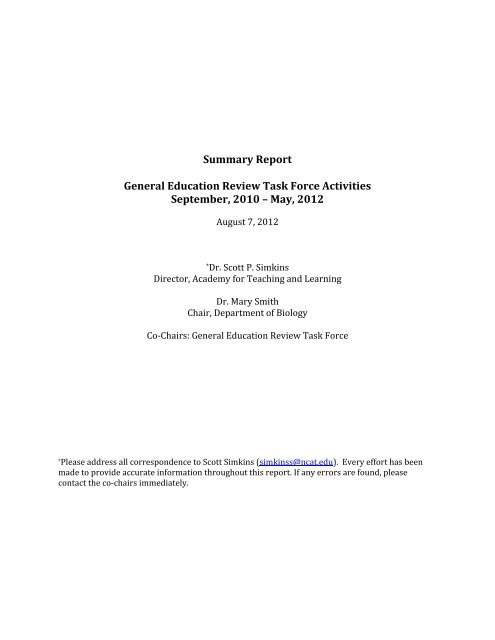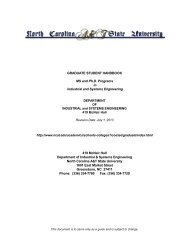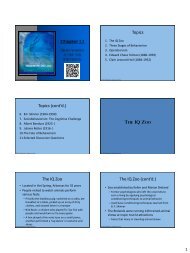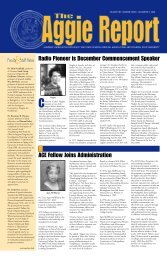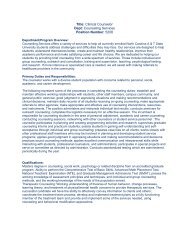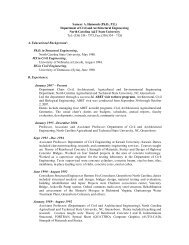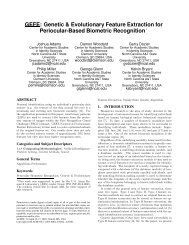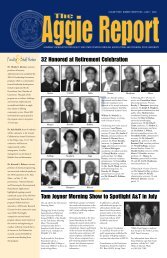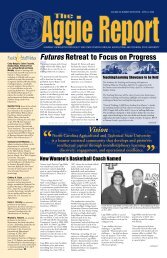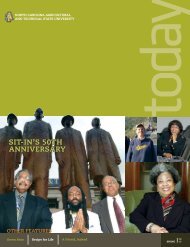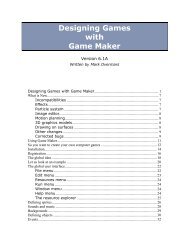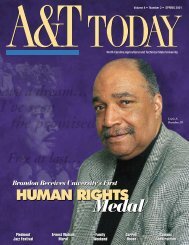Summary Report - North Carolina A&T State University
Summary Report - North Carolina A&T State University
Summary Report - North Carolina A&T State University
You also want an ePaper? Increase the reach of your titles
YUMPU automatically turns print PDFs into web optimized ePapers that Google loves.
LIST OF TABLES Table Table 1: <strong>University</strong>-‐Wide General Education Discussion/Feedback Meetings – March/April 2011 Page 8 Table 2: <strong>University</strong>-‐Wide General Education Discussion/Feedback Meetings – September/October, 2011 10 Table 3: Substitutes for UNST Foundation Courses (Continuing Students) 12 Table 4: General Education Requirements (Effective Fall, 2012) – Student Learning Outcomes and Credit Hour Structure 14
3 1. Overview This report provides a summary of General Education Review Task Force (hereafter “Task Force”) activities during the period September, 2010 – May, 2012. During this 20-‐month period the Task Force: reviewed the <strong>University</strong> Studies general education curriculum, including an external review report analyzed national “best practices” in general education reviewed general education requirements of peer institutions created a comprehensive set of general education student learning outcomes based on national “best practices,” peer institution review, NC A&T department-head survey responses, and NC A&T Strategic Planning Review Committee-‐Subcommittee on Teaching and Learning recommendations led university-‐wide discussion/feedback sessions (beginning in spring, 2011) to provide updates and obtain feedback on proposed changes in the general education program developed a general education curricular structure promoting twenty-‐first century learning outcomes and simplifying transfer from NC community colleges gained Faculty Senate approval for new general education student learning outcomes and curricular structure developed a process for reviewing and approving courses for inclusion in a comprehensive general education course list reviewed more than 100 general education course proposal packages developed an initial general education course list for fall, 2012 freshman registration led May, 2012 ATL Summer Teaching Institute sessions on student learning outcome development and assessment of student learning (to facilitate departmental revision of General Education Course List Addition Forms for “conditionally approved” courses) The new general education curriculum was approved by the Faculty Senate in November, 2011 and implemented beginning with the fall, 2012 freshman class. 2. Background and Context: Recent General Education Revision at <strong>North</strong> <strong>Carolina</strong> A&T <strong>State</strong> <strong>University</strong> <strong>University</strong> Studies (UNST) was implemented in fall, 2006 as the university’s general education program following four years of general education review, planning, and campus-‐wide discussion. <strong>University</strong> Studies marked a significant departure from the previous distribution-‐requirement model for general education, requiring a common set of four freshman-‐level “foundation” courses, four courses in “thematic clusters,” and a capstone experience. In addition, <strong>University</strong> Studies created a new administrative structure, with a Dean of <strong>University</strong> Studies and a group of <strong>University</strong> Studies faculty members reporting to this Dean. Most foundation-‐level courses were taught by <strong>University</strong> Studies faculty members, with the remainder of the curriculum taught by a mixture of faculty members from <strong>University</strong> Studies and other academic schools and colleges, most notably the College of Arts and Sciences.
4 An external review of the <strong>University</strong> Studies administrative and curricular structure was undertaken in September, 2009 as previously requested by the Faculty Senate. The resulting external review report was shared with the Chancellor’s Cabinet, deans, <strong>University</strong> Studies administrators and faculty members, and the Faculty Senate in October, 2009. <strong>University</strong> actions in response to the external review were outlined in a November 16, 2009 memo to the university community from Chancellor Harold Martin (see Appendix A). 1 The memo discussed the creation of two <strong>University</strong> Studies Review Task Forces: (1) a group (Task Force #1) to “review the recommendations from the assessment report and propose ‘the best administrative structure’ through which our general education requirements should be delivered,” and (2) a group (Task Force #2) to “assess nonadministrative matters related to UNST,” including the mission, goals, objectives, and curricular structure of the university’s general education program. The two Task Force groups operated sequentially, with Task Force #1 completing its work in spring, 2010, followed by the creation of Task Force #2 in fall, 2010. A May 13, 2010 memo to the university community from the chancellor (see Appendix A) announced a July 1, 2010 phase-‐out of the Division of <strong>University</strong> Studies, with <strong>University</strong> Studies faculty members re-‐assigned to “academic departments that match their academic qualifications and their scholarly and research interests.” This memo also reaffirmed the creation of a second <strong>University</strong> Studies Review Task Force (Task Force #2) to carry out a comprehensive review of the university’s general education requirements and make recommendations for creating a “more robust, intentional, and well-understood general education program -‐ one that is purposeful in design and implementation, integrative and ambitious in its mission, innovative and creative in its pedagogical and assessment practices, and focused on improving student learning outcomes.” Finally, the memo noted that <strong>University</strong> Studies would remain as the general education curriculum for the university until Task Force #2 completed its work and a new general education program was developed and implemented. Task Force #2, named the General Education Review Task Force, was created in September, 2010 by Provost Linda Adams, who replaced Interim Provost Alton Thompson in July, 2010. 3. General Education Review Task Force Charge and Membership a. General Education Review Task Force Charge The General Education Review Task Force was created in September, 2010 to review the academic content and structure of the <strong>University</strong> Studies program and make recommendations for revision based on its findings. In particular, Task Force was asked 1 As noted in the memo, the external review team was asked to review the following <strong>University</strong> Studies program components: curriculum requirements, co-‐curricular program, student learning outcomes and assessment of those outcomes, transfer of credit and other policies, faculty qualifications and credentialing, administrative structure and managerial operations, budget, website, annual reports, and overall institutional satisfaction.
5 to (see Appendix D, General Education Review Task Force Appointment Letter - Sept. 2, 2010): Review the mission, goals, objectives, and core course requirements of the general education program Review national general education “best practices” that align with the heritage, mission, goals, and strategic plan of <strong>North</strong> <strong>Carolina</strong> A&T <strong>State</strong> <strong>University</strong> to achieve academic and operational excellence Review and evaluate the findings and recommendations of the (<strong>University</strong> Studies) external assessment team Host information gathering forums and other meetings to enable critical university stakeholders to appropriately inform the general education review process Formulate preliminary recommendations regarding the structure and content of the general education curriculum and supporting programs for review by the university’s governing bodies Summarize and distribute revised recommendations of the Task Force for consideration by the Faculty and Deans Present a final report of the General Education Review Task Force to the Provost While no specific deadline for completion of Task Force duties was included in the initial appointment letter, the Provost stressed an “aggressive timeline” in her discussions with the co-‐chairs and full Task Force. A target date of fall, 2012 was proposed for implementation of a new general education curriculum to replace <strong>University</strong> Studies. b. General Education Review Task Force Membership In August, 2010 the Provost appointed Dr. Scott Simkins, director of the Academy for Teaching and Learning and Associate Professor of Economics, and Dr. Mary Smith, chair of the Department of Biology, to co-‐chair the Task Force. In late August, 2010 the Provost asked the deans to select school/college faculty and student representatives for inclusion on the Task Force, according to the following plan: One faculty representative from each undergraduate school/college, with the exception of the College of Arts and Sciences (2-‐3 representatives) due to this college’s over-‐representation in the general education curriculum. Two additional College of Arts and Sciences faculty members who were part of <strong>University</strong> Studies One undergraduate student representative from each school/college. In addition, the Provost appointed various general education stakeholders to the Task Force, including representatives from the following areas: Office of Undergraduate Research, Honors Program, Center for Academic Excellence, Institutional Research, Enrollment Management, Army ROTC, Division of Information Technology, International Programs, Student Affairs, Faculty Senate, and the Institutional Effectiveness Council. The initial Task Force included a total of 31 members, including 12 faculty members, 12 administrators, and 7 undergraduate students. Appointment letters were distributed to Task Force members on September 2, 2010. Two additional Student Affairs representatives were added in 2010-‐11, along with a representative from Bluford
6 Library, for a total of 34 members (see Appendix D, General Education Review Task Force Appointment Letter - Sept. 2, 2010). 2 Some concerns were raised by the Faculty Senate and other faculty members about the large number of administrators included on the General Education Review Task Force. However, it was argued at the time that all related stakeholders should participate in the discussion and revision of a new general education curriculum. In practice, faculty members on the Task Force led and completed the vast majority of tasks, including the development of general education student learning outcomes and the curricular structure of the general education program. 4. General Education Review and Revision: A Chronological <strong>Summary</strong> of General Education Review Task Force Activities (Fall 2010 – Summer 2012) Each section below includes a general overview of Task Force activities for the indicated semester, along with a bulleted list providing specific Task Force meeting dates and topics. Agendas for all General Education Review Task Force meetings are included in Appendix B. a. Fall 2010 The Task Force met five times during the fall, 2010 semester (approximately once per month), beginning September 20, 2012. At the first meeting, Provost Adams provided the Task Force with its charge, including guiding principles and a timeline for completion of its work. In particular, a target date of fall, 2012 was given for implementation of a new general education curriculum to replace <strong>University</strong> Studies. During the fall semester the Task Force reviewed <strong>University</strong> Studies information, the general education requirements of UNC peer institutions (including aspirational peers), and national best practices in general education. The Task Force also began to identify broad areas for general education student learning outcome development. Specific Topics and Meeting Dates Discussed the Task Force charge, guidelines, and timeline for completion of duties (Sept. 20, 2010) Reviewed <strong>University</strong> Studies reports, including the report of the external review team and relevant sections of the most recent NC A&T <strong>State</strong> <strong>University</strong> SACS Self-‐Study <strong>Report</strong>, and summarized strengths and weaknesses of the <strong>University</strong> Studies program (Oct. 4, 2010) Reviewed nationally-‐recommended (AAC&U) general education student learning outcomes and best practices in general education design, pedagogy, and assessment (Oct. 25 and Nov. 8, 2010) 2 The following changes to the initial Task Force membership were made during 2010-‐2012: Denise Iverson-‐Payne and Bonnie Candia were added from Student Affairs in September, 2010; Mike Cundall (Honors Program) joined in Feb., 2011, replacing Ray Davis; and Ken Roberts (College of Engineering) joined in March, 2011, replacing Corey Graves. Kate Silton (Bluford Library) was added in April, 2011. Donald McDowell (School of Agriculture and Environmental Sciences) joined Sept., 2011, replacing Geraldine Ray; Keyana Scales (Admissions) joined Sept., 2011, replacing Lori Hunter.
7 Reviewed UNC Peer Institution general education requirements (Nov. 29, 2010) Participated in UNC-‐Greensboro Mini-‐Institute on General Education, which included presentations by national leaders in general education reform from AAC&U (Dec. 8-‐9, 2010) b. Spring 2011 The Task Force increased the frequency of its meetings during the spring, 2011 semester, meeting seven times (approximately bi-‐weekly), beginning in early February. In early January, 2011 the Task Force asked academic departments to discuss, rank, and submit “5-‐7 university-‐level student learning outcomes that all graduates should achieve by the time they graduate.” This information, along with general student learning outcomes obtained from a review of UNC peer institutions, fall 2010 Task Force discussions, national best practices (in particular, AAC&U’s LEAP Essential Learning Outcomes), and independent analysis by the NC A&T Strategic Planning Review Committee-‐Subcommittee on Teaching and Learning, was used to develop an initial set of NC A&T general education student learning outcomes for campus-‐wide discussion and feedback in March, 2011. A final set of general education student learning outcomes was approved by the NC A&T Faculty Senate on April 26, 2011 and used to develop a draft version of general education curriculum requirements in early May, 2011. This draft curricular structure was used for campus discussion and feedback beginning with the Chairs’ Retreat in June, 2011 and continuing in September, 2011 (see Appendix C, General Education Review Task Force Update – March 1, 2011 and Proposed General Education Curriculum Requirements (DRAFT) – Sept. 1, 2011). Specific Topics and Meeting Dates Reviewed results of NC A&T departmental survey on student learning outcomes (Feb. 7, 2011) Developed a list of 6 university-‐wide general education student learning outcomes for discussion at school/college, academic support unit, and Faculty Senate meetings during March, 2011; this list was developed from January, 2011 departmental survey results, recommendations from the NC A&T Strategic Planning Review Committee-‐Subcommittee on Teaching and Learning, national recommendations (AAC&U LEAP Essential Learning Outcomes), peer institution reviews, and Task Force discussions from fall, 2010 (Feb. 22, 2011) Reviewed SACS principles for general education and NC Community College Articulation Agreement (March 14, 2011) Reviewed general education proposals from the following departments: Foreign Languages, History, English (March 29, 2011 and April 11, 2011) Revised proposed general education student learning outcomes based on feedback from March campus-‐wide discussions (April 11 and April 26, 2011) Obtained Faculty Senate approval for general education student learning outcomes (April 26, 2011) Developed “beta draft” of general education curriculum structure (May 15, 2011) (co-‐chairs) Led discussion of draft general education curricular structure at Chairs’ Retreat (June, 2011)
8 Campus-wide Discussion/Feedback Sessions The co-‐chairs led 13 presentations on proposed general education student learning outcomes during March and April, 2011, as listed in Table 1. The purpose of these meetings was to update campus stakeholders on activities of the Task Force and obtain feedback on the proposed general education student learning outcomes. A two-‐page handout summarizing the key guidelines for general education revision, outlining proposed university-‐wide student learning outcomes, and providing a timeline for meeting Task Force goals was developed for these meetings (see Appendix C, General Education Review Task Force Update – March 1, 2011). Table 1 <strong>University</strong>-‐Wide General Education Discussion/Feedback Meetings March/April 2011 Date Group 3/1/11 Administrative Council 3/9/11 Bluford Library 3/14/11 School of Nursing 3/16/11 School of Business and Economics 3/17/11 College of Arts and Sciences 3/17/11 School of Agriculture and Environmental Sciences 3/18/11 Chairs’ Forum 3/25/11 College of Engineering 3/25/11 School of Technology 3/29/11 Student Affairs 3/29/11 Faculty Senate 4/11/11 Chancellor’s Cabinet 4/29/11 School of Education c. Fall 2011 The Task Force met seven times during the fall, 2011 semester (approximately bi-weekly). During September the Task Force co-‐chairs led 17 discussion/feedback sessions across the university on the proposed general education curriculum drafted in May, 2011 (see Table 2). Responding to feedback from these meetings and follow-‐up meetings with department chairs in various schools/colleges in late September and early October, 2011, the Task Force made significant changes to the proposed general education curriculum (to ease community college transfer credit, reduce overall credit requirements, and eliminate the service-‐learning requirement), with a revised version presented to the Faculty Senate (for discussion and feedback) at its October meeting (see Appendix C: NC A&T <strong>State</strong> <strong>University</strong> General Education Revision Update – Oct. 21, 2011). The final proposed general education curriculum was presented to the campus at a university-‐wide Faculty Forum session on Nov. 2, 2011 for discussion and feedback. Minor changes were made to the rules for transfer-‐credit acceptance following the Faculty Forum, with a final version of the general education curriculum approved by the Faculty Senate on Nov. 22, 2011. A Dec. 8, 2011 memo from the Provost to the university
9 community announced the new general education curriculum (see Appendix D: General Education Revision). During September and October, 2011 Task Force sub-‐committees began to develop and revise comprehensive general education student learning outcomes, along with explanatory narratives and examples, for each of the broad student learning outcome categories approved by the Faculty Senate in April, 2011. Input was also requested from a small group of Institutional Effectiveness Council (IEC) members with expertise in assessment of the designated categories regarding the wording of these student learning outcomes. Results from the Task Force sub-‐committees and IEC group were combined to develop a final set of general education student learning outcomes and accompanying narratives and examples in December, 2011 and January, 2012. In fall, 2011 the Task Force also began to develop initial plans for reviewing and approving courses for inclusion in a general education course list, and, in collaboration with the Faculty Senate, developed initial guidelines for creating a new university-‐wide general education committee to replace the General Education Review Task Force. Specific Topics and Meeting Dates Reviewed feedback on proposed general education curricular structure from summer, 2011 Chairs’ retreat, outlined protocols for September, 2011 university-wide discussion/feedback sessions, and initiated student learning outcome narratives development (sub-‐committees) (Sept. 7, 2011) Reviewed feedback from school/college discussion/feedback sessions, initiated processes for creating a permanent university-‐level general education curriculum committee, and began discussions regarding an approval process for general education course proposals (Sept. 21, 2011) Discussed issues raised in September university-‐wide discussion/feedback meetings, created initial draft of future general education committee duties and responsibilities, and reviewed sub-‐committee reports of student learning outcome narratives/examples (Sept. 28, 2011) Reviewed progress to date and next steps with respect to proposed general education curriculum, discussed revised general education option developed in response to feedback from September discussion/feedback sessions, and reviewed results of Faculty Senate Educational Policies Subcommittee meeting regarding future development of a university-‐wide general education committee (Oct. 12, 2011) Reviewed general education curriculum discussed at Faculty Senate meeting and to be presented at upcoming Faculty Forum and reviewed progress on development of general education committee, student learning outcome narratives, and general education course proposal process (Oct. 26, 2011) Discussed final modification to general education curriculum based on Faculty Forum comments and reviewed progress on general education student learning outcome narratives, course proposal process, and development of general education committee (Nov. 9, 2011) Discussed Faculty Senate approval of general education curriculum and student learning outcomes and reviewed progress on general education student learning outcome narratives and the process for developing a comprehensive general education course list (Nov. 30, 2011)
10 Campus-wide Discussion/Feedback Sessions The co-‐chairs led 17 discussion/feedback sessions on the proposed general education curricular structure and student learning outcomes during September and October, 2011, as listed in Table 2. The co-‐chairs also led follow-‐up meetings with department chairs in multiple schools/colleges in late September and early October, including two meetings with chairs in the College of Arts and Sciences, where the majority of general education courses are taught. Table 2 <strong>University</strong>-‐Wide General Education Discussion/Feedback Meetings September-‐October, 2011 Date Group 9/6/11 Chancellor’s Cabinet 9/7/11 Student Affairs -‐ Directors' Meeting 9/9/11 School of Technology 9/12/11 School of Nursing 9/13/11 Administrative Council 9/13/11 Teacher Education Council (School of Education) 9/14/11 Bluford Library 9/16/11 School of Education 9/20/11 College of Engineering 9/21/11 School of Business and Economics 9/22/11 Center for Academic Excellence 9/27/11 Faculty Senate Meeting 9/22/11 School of Agriculture and Environmental Sciences 10/4/11 College of Arts and Sciences 10/12/11 College of Arts and Sciences – Chairs and Program Directors 10/17/11 Chancellor’s Cabinet 10/25/11 Faculty Senate Meeting d. Spring 2012 During December, 2011 and January, 2012 Task Force co-‐chairs developed guidelines, instructions, and draft forms for departments to request courses for inclusion on the general education course list. These forms require departments to provide course-‐level student learning outcomes for the requested general education category, plans for formative and summative assessment of these learning outcomes, criteria for determining whether the outcomes have been met, and plans for course improvement based on assessment data. The Task Force met on Feb. 1, 2012 to review final versions of these documents before being released to the campus community on Feb. 3, 2012 along with a memo from the Provost outlining procedures and timelines for submitting courses for review by the Task Force (see Appendix D, Implementation of the General Education Curriculum). The forms and instructions have been available for download on the university’s web site
11 (http://www.ncat.edu/provost/general_education_resources/index.html) since then (see Appendix E). Task Force members reviewed an initial group of 78 general education course proposal packages on Feb. 21, 2012. As a result of this initial review process, 15 courses were approved for inclusion on the general education course list, 51 were “conditionally approved,” and 12 were rejected. Approved course packages were then sent to the Faculty Senate Curriculum Committee for review and approval, with final approval by the full Faculty Senate on Feb. 28, 2012. On April 10, 2012 the Task Force reviewed an additional 27 general education course proposal packages; 2 were approved for inclusion on the general education course list, 13 were “conditionally approved,” and 12 were rejected. Approved course packages were then sent to the Faculty Senate Curriculum Committee for review and approval, with final approval by the full Faculty Senate on April 24, 2012. As of May 1, 2012 there were 17 fully approved courses on the general education course list, with another 64 “conditionally approved.” Conditionally approved courses had one or more deficiencies in their application package (student learning outcomes, assessment plans, criteria for determining whether the learning outcome was met, or assessment-based plans for improvement) but were expected to be included on the general education course list after suitable revisions to the course proposal package. Both approved and conditionally approved courses were included in the initial comprehensive course list used for registration of incoming freshman in summer, 2012 (see Appendix F). 3 A March 12, 2012 memo from the Provost (see Appendix D, General Education Revision Update) announced that <strong>University</strong> Studies (UNST) courses would no longer be offered following the spring, 2012 semester. An April 30, 2012 memo from the Provost (see Appendix D, General Education Curriculum) outlined substitute courses for continuing students requiring UNST foundation-‐level courses (UNST 100, UNST 110, UNST 120, UNST 130, UNST 140) due to course failure, course withdrawal, or because they have not yet taken one or more of these courses. The course substitutions are listed in Table 3 on the following page. At its April 24, 2012 meeting, the Faculty Senate voted to eliminate outcome #2 (Assess the impact of scientific inquiry on society) from the Scientific Reasoning general education student learning outcomes developed by the General Education Task Force and used in the general education course request process (see Appendix E). The Faculty Senate formally approved the complete set of general education student learning outcomes used in the General Education Course List Addition forms, subject to this single modification. 3 Note that courses may be requested to be included on the general education course list at any time. Between May 1, 2012 and June 15, 2012 three departments requested that courses be removed from the general education course list (AGED 200, ECON201, and PSYC320). At the time of this report, discussions are underway to add the latter two courses back on the general education course list.
12 Table 3 Substitutes for UNST Foundation Courses (Continuing Students) UNST Course UNST 100 UNST 110 UNST 120 UNST 130 UNST 140 Substitute Course (beginning Summer 2012) FRST 100 ENGL 100 HIST 130 PHIL 268 HIST 202 Specific Topics and Meeting Dates Reviewed final versions of guidelines, instructions, and general education course proposal forms used for requesting courses to be included in the comprehensive general education course list (Feb. 1, 2012) Conducted review of initial group of 78 general education course proposal packages (Feb. 21, 2012) Conducted review of second group of 28 general education course proposal packages (April 10, 2012) 5. Current Status (Summer 2012) a. General Education Curriculum The new general education requirements passed by the Faculty Senate in November, 2011 are listed in Table 4 (p. 14). The general education curriculum includes 33 semester hours of credit distributed across six broad categories of student learning: written communication; mathematical, logical, and analytical reasoning; scientific reasoning; social/behavioral sciences; humanities/fine arts; and student success. Within the social/behavioral sciences and humanities/fine arts categories (combined), students are required to complete at least three semester credit hours of courses with an African-‐American Studies (AA) designation (or “marker”) and at least three semester hours of courses with a Global Studies (GS) designation (or “marker”). The general education curriculum also requires an additional four learning outcomes to be infused throughout the undergraduate curriculum and assessed at the program (departmental) level: critical thinking, oral communication, ethical reasoning, and writing in the major. These four student-‐learning outcomes do not include minimum-‐hour requirements. b. General Education and Transfer from <strong>North</strong> <strong>Carolina</strong> Community Colleges The new general education curriculum will make transfer from <strong>North</strong> <strong>Carolina</strong> community colleges easier, relative to the previous <strong>University</strong> Studies curriculum. Students transferring to NC A&T <strong>State</strong> <strong>University</strong> with an AA or AS degree (or completing the general education core, even without an AA or AS degree) from an accredited <strong>North</strong>
13 <strong>Carolina</strong> community college will have met all credit requirements for the NC A&T <strong>State</strong> <strong>University</strong> general education curriculum. In addition, for students transferring to NC A&T <strong>State</strong> <strong>University</strong> with an AA or AS degree from an accredited <strong>North</strong> <strong>Carolina</strong> community college, academic programs are required to account for earned credit hours in the social/behavioral sciences and humanities/fine arts categories beyond those required by the NC A&T <strong>State</strong> <strong>University</strong> general education curriculum by substituting a minimum of 6 hours of free and/or appropriate program electives, as necessary. c. Next Steps As noted in the April 30, 2012 memo from the Provost (see Appendix D, General Education Curriculum), plans were made to assist departments during summer, 2012 with revisions to course proposal packages from “conditionally accepted” courses. For example, the Academy for Teaching and Learning (ATL) Summer Teaching Institute, held on May 16, 2012, was devoted to this task, with individual follow-‐up by the ATL director (with departments requesting assistance) during June, July, and August. It is expected that revised general education course proposal packages will be submitted by academic departments in mid-‐August, with review by the Task Force in late August. The Task Force expects to complete its work and transition its duties to a new university-wide general education committee by December, 2012.
14 Table 4 General Education Requirements (Effective Fall, 2012) Student Learning Outcomes and Credit Hour Structure Student Learning Outcome Written Communication Mathematical, Logical, and Analytical Reasoning (at least one course with MATH prefix) Scientific Reasoning (at least one lab-‐based course) Social/Behavioral Sciences* Humanities/Fine Arts* Credit Hours 6 6 7 6 6 * Of the 12 total hours in social/behavioral sciences and humanities/fine arts, at least 3 hours must be completed in African-‐American studies courses and 3 hours in global studies courses Student Success (to be met through courses offered by a department, school/college, the Center for Academic Excellence, or any combination of the above) TOTAL CREDIT HOURS: 2 33 Additional General Education Student Learning Outcomes To be infused throughout the curriculum (no credit hour requirement) and assessed at the program level: critical thinking, oral communication, ethical reasoning, and writing in the major. Special Note Regarding NC Community College Transfer (1) Students transferring to NC A&T <strong>State</strong> <strong>University</strong> with an AA or AS degree (or completing the general education core, even without an AA or AS degree) from a NC community college will have met all credit requirements for the NC A&T <strong>State</strong> <strong>University</strong> general education curriculum. (2) For students transferring to NC A&T <strong>State</strong> <strong>University</strong> with an AA or AS degree from an accredited <strong>North</strong> <strong>Carolina</strong> community college, academic programs are required to account for earned credit hours in social/behavioral sciences and humanities/fine arts beyond those required by the NC A&T <strong>State</strong> <strong>University</strong> general education curriculum by substituting a minimum of 6 hours of free and/or appropriate program electives, as necessary.
15 SELECTED BOOKS AND READINGS ON GENERAL EDUCATION REVISION Association of American Colleges and Universities & National Leadership Council. (2007). College learning for the new global century: A report from the National Leadership Council for Liberal Education & America's Promise. Washington, D.C: Association of American Colleges and Universities. Association of American Colleges and Universities. (2002). Greater expectations: A new vision for learning as a nation goes to college: National panel report. Washington, DC: Association of American Colleges and Universities. Barr, R. B. & Tagg, J. (1995). From teaching to learning – a new paradigm for undergraduate education. Change, 27 (6): 12-‐25. *Brownell, J. E. & Swaner, L. E. (2010). Five high-impact practices: Research on learning outcomes, completion and quality. Washington, D.C: Association of American Colleges and Universities. *Gaston, P. L. & Clark, E. J. (2010). General education & liberal learning: Principles of effective practice. Washington, DC: Association of American Colleges and Universities. Hamilton, S. J., Banta, T. W. & Evenbeck, S. E. (2006). Six principles of undergraduate learning: The not-‐so-‐easy road to writing and committing to them. About Campus, 11 (4): 9-‐17. Head, A. J. & Eisenberg, M. B. (2010). How college students evaluate and use information in the digital age. Project Information Literacy Progress <strong>Report</strong>. <strong>University</strong> of Washington Information School. Online: http://projectinfolit.org/pdfs/PIL_Fall2010_Survey_Full<strong>Report</strong>1.pdf Hutchings, P. (2010). Opening doors to faculty involvement in assessment. (NILOA Occasional Paper No.4). Urbana, IL: <strong>University</strong> of Illinois and Indiana <strong>University</strong>, National Institute of Learning Outcomes Assessment. Online: http://www.learningoutcomeassessment.org/documents/PatHutchings_000.pdf *Kuh, G. D., Schneider, C. G. & Association of American Colleges and Universities. (2008). High-impact educational practices: What they are, who has access to them, and why they matter. Washington, DC: Association of American Colleges and Universities. Mehaffy, G. L. (2010). The red balloon project: Re-‐imagining undergraduate education, manuscript, American Association of <strong>State</strong> Colleges and Universities (AASCU). Published as: Medieval models, agrarian calendars and 21st century imperatives, Teacher - Scholar: The Journal of the <strong>State</strong> Comprehensive <strong>University</strong> (Fall, 2010). Online: http://www.aascu.org/meetings/aa_summer10/RedBalloonProject.pdf National Leadership Council, Liberal Education and America's Promise & Association of American Colleges and Universities. (2008). College learning for the new global century: Executive summary with employers' views on learning outcomes and assessment approaches. Washington, D.C: Association of American Colleges and Universities. Schneider, C. G. (2010). General education 1.0: An efficiency overhaul for the cold war curriculum. Liberal Education, 96 (4): 2-‐3. Online: http://www.aacu.org/liberaleducation/le-‐fa10/LEFA10_President.cfm Stearn, P. N. (2010). Global education and liberal education. Liberal Education, 96 (3): 18-‐23. Online: http://www.aacu.org/liberaleducation/le-‐su10/LESU10_Stearns.cfm * = key references (provided for all General Education Review Task Force members)
16 SELECTED WEB RESOURCES ON GENERAL EDUCATION REVISION Periodicals Related to General Education About Campus: http://www2.myacpa.org/publications/about-‐campus/current-‐issue CHANGE: http://www.changemag.org/ Liberal Education: http://www.aacu.org/liberaleducation/index.cfm Peer Review: http://www.aacu.org/peerreview/index.cfm AAC&U Website: A wide variety of publications related to general education http://www.aacu.org/resources/generaleducation/index.cfm Bill and Melinda Gates Foundation -‐ PostSecondary Education Project http://www.gatesfoundation.org/postsecondaryeducation/Pages/default.aspx Lumina Foundation – Goal 2025 Project http://www.luminafoundation.org/goal_2025/ http://www.luminafoundation.org/goal_2025/Lumina_Strategic_Plan.pdf National Institute for Learning Outcomes Assessment (NILOA) http://www.learningoutcomeassessment.org/index.html The Teagle Foundation – Outcomes and Assessment Project http://www.teaglefoundation.org/ The Teagle Foundation – Assessment of Liberal Learning Resources http://www.teaglefoundation.org/learning/resources.aspx#assessment NORTH CAROLINA A&T STATE UNIVERSITY GENERAL EDUCATION FORMS AND RESOURCES Provost/Academic Affairs Web Site (see General Education link) http://www.ncat.edu/provost/Index.html Direct Link to General Education Resources: http://www.ncat.edu/provost/general_education_resources/index.html
17 APPENDIX A: <strong>University</strong> Studies Review APPENDICES • Memo from Chancellor – <strong>University</strong> Studies Assessment (Nov. 16, 2009) – outlining the process for responding to the results of the <strong>University</strong> Studies external review • Memo from Chancellor – <strong>University</strong> Studies Realignment (May 13, 2010) – announcing dissolution of <strong>University</strong> Studies administrative structure, re-‐assignment of <strong>University</strong> Studies faculty to existing academic departments, and establishment of task force to assess academic matters related to <strong>University</strong> Studies APPENDIX B: General Education Review Task Force Meeting Agendas (Sept., 2010 – May, 2012) APPENDIX C: General Education Student Learning Outcomes and Curriculum Development • General Education Review Task Force Update (March 1, 2011) – includes student learning outcomes passed by Faculty Senate April 26, 2011 • Request for Faculty Senate Vote on General Education Student Learning Outcomes (April 12, 2011) • Proposed General Education Curriculum Requirements (DRAFT) – initial draft (developed in May, 2011) for campus-‐wide discussion and feedback (Sept. 1, 2011) • NC A&T <strong>State</strong> <strong>University</strong> General Education Revision Update (Oct. 21, 2011) APPENDIX D: General Education Memos from the Provost • General Education Review Task Force Appointment Letter (Sept. 2, 2010) – charge, duties, membership roster • General Education Curriculum (March 18, 2011) – includes UNST Thematic Cluster course substitution policy • General Education Revision (Dec. 8, 2011) – announcing Faculty Senate approval of new general education curriculum and process for developing general education course list • Implementation of the General Education Curriculum (Feb. 3, 2012) – describing process for requesting courses to be included on general education course list • General Education Revision Update (March 12, 2012) – announcing full implementation of new general education requirements in January 2013 and plans for transitioning to the new general education curriculum for entering freshman students in fall 2012 • General Education Curriculum (April 30, 2012) – information on general education revisions to the Undergraduate Bulletin, substitutions for <strong>University</strong> Studies foundation-‐level courses, and plans for moving “conditionally-‐accepted” general education courses to “accepted” status APPENDIX E: General Education Course Addition Request Forms (from web site) • Process for Adding A Course to the General Education Course List (2 pages) • A Guide to General Education Student Learning Outcomes – Aug. 5, 2012 (9 pages) • Criteria for Reviewing General Education Course Requests (4 pages) • General Education Course List Addition Forms (8 forms, one for each general education category) APPENDIX F: General Education Course List – June 15, 2012


